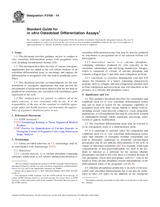We need your consent to use the individual data so that you can see information about your interests, among other things. Click "OK" to give your consent.
ASTM F3106-14
Standard Guide for in vitro Osteoblast Differentiation Assays
STANDARD published on 1.10.2014
The information about the standard:
Designation standards: ASTM F3106-14
Note: WITHDRAWN
Publication date standards: 1.10.2014
SKU: NS-579684
The number of pages: 5
Approximate weight : 15 g (0.03 lbs)
Country: American technical standard
Category: Technical standards ASTM
The category - similar standards:
Annotation of standard text ASTM F3106-14 :
Keywords:
connective tissue progenitor stem cells, mesenchymal stem cells, mineralization assay, osteoblastic progenitor cells, osteoblasts,, ICS Number Code 11.040.40 (Implants for surgery, prothetics and orthotics)
Additional information
| Significance and Use | ||||
|
4.1 This guidance document describes the components and conditions used for in vitro osteoblast differentiation assays that can be used to screen for the osteogenic capability of progenitor stem cells from various human or animal sources, including mixed tissue-derived connective tissue progenitor populations, or cell populations that may be selectively isolated or manipulated through culture expansion, processing, transfection or genetic modification. 4.2 The osteoblast differentiation assay may be referred to as an osteogenesis assay or a mineralization assay. 4.3 It is important to carefully select the components and conditions used for in vitro osteoblast differentiation assays since high amounts of osteogenic medium components can lead to dystrophic, pathologic or artifactual calcium-based precipitates that do not indicate differentiation of the cells in culture to functional osteoblasts 4.4 Alkaline phosphatase production is an early event associated with osteoblast differentiation but it can also be stimulated in other cell types by the addition of the osteogenic supplement dexamethasone to the medium. Alkaline phosphatase enhances the formation of calcified deposits prior to their natural occurrence in bone that typically coincides with bone sialoprotein and osteocalcin expression by mineralized matrix-producing osteoblasts. These kinds of calcified/mineral deposits are thus considered dystrophic, pathologic, or artifactual because they were not initiated by a mature osteoblast. A calcium measurement, such as that described in Practice F2997 for the Quantification of Calcium Deposits in Osteogenic Culture of Progenitor Cells Using Fluorescent Image Analysis, may thus result in a potentially false interpretation of the differentiation status of osteoprogenitor cells if used in isolation without gene or protein expression data. 4.5 In addition to screening for multipotentiality of undifferentiated stem cells, osteoblast differentiation assays are useful for assessing the osteoinductivity of cell culture substrates or biomaterial scaffolds or drugs or biomolecules; such as, cytokines or growth factors. 4.6 In vitro osteoblast differentiation assays are not predictive of 1.1 This document provides guidance on how to conduct 1.2 This document describes the roles of various osteogenic supplements that are added to the cell culture medium of an osteoblast differentiation assay to encourage and support the differentiation of progenitor cells into matrix-producing osteoblasts. 1.3 This document provides recommendations for the concentrations of osteogenic supplements that may prevent the precipitation of artifactual mineral deposits that are not directly produced by osteoblasts, nor correlated with osteoblastic gene expression of the cells. 1.4 This standard does not purport to address all of the safety concerns, if any, associated with its use. It is the responsibility of the user of this standard to establish appropriate safety and health practices and determine the applicability of regulatory limitations prior to use. |
||||
| 2. Referenced Documents | ||||
|
We recommend:
Technical standards updating
Do you want to make sure you use only the valid technical standards?
We can offer you a solution which will provide you a monthly overview concerning the updating of standards which you use.
Would you like to know more? Look at this page.




 Cookies
Cookies
